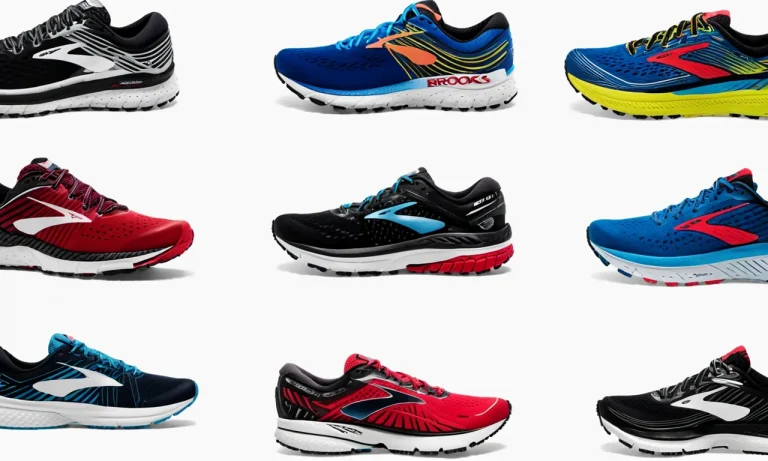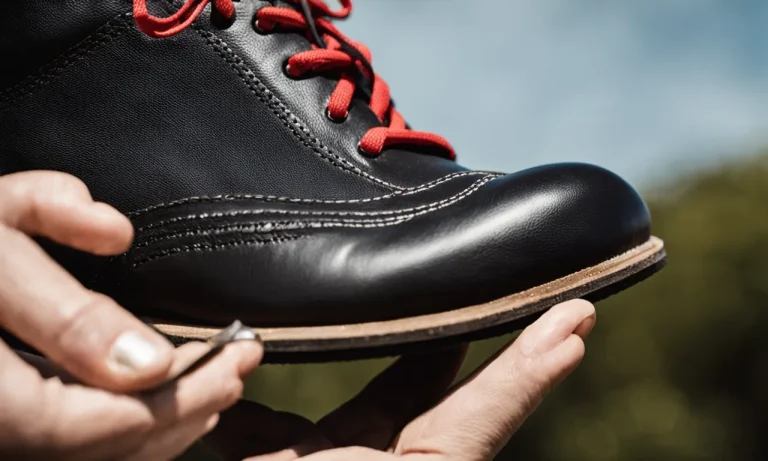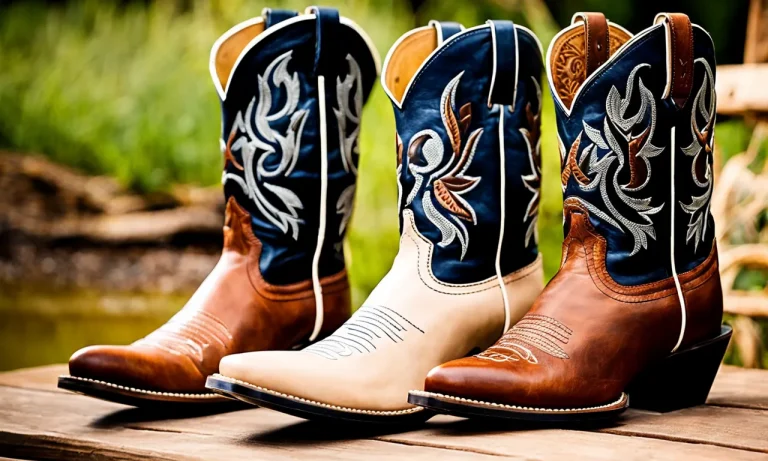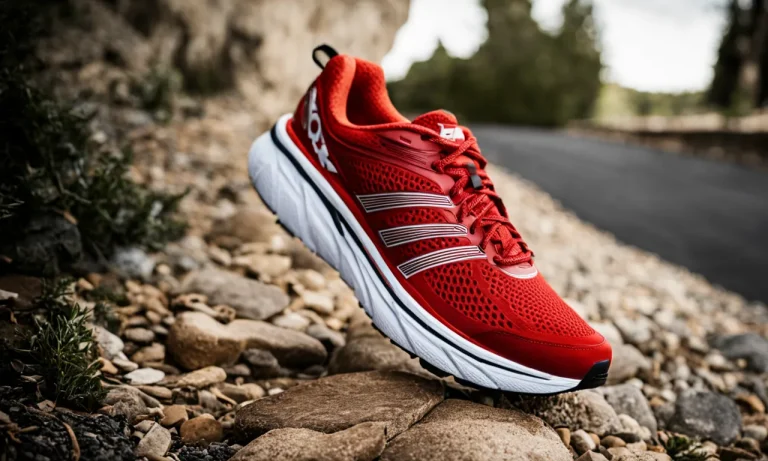If you’ve ever walked around in boots that squeak loudly with each step, you know how annoying it can be. A squeaky boot not only draws unwanted attention but can also signal poor quality and wear. Luckily, squeaky boots can often be fixed with some simple DIY solutions.
If you’re short on time, here’s a quick answer to your question: Boots typically squeak due to pressure forcing out trapped air in the sole. Applying talcum powder, wax, silicone spray, or petroleum jelly to the sole can help reduce friction and stop the squeaking.
In this comprehensive guide, we’ll cover all the reasons boots squeak and provide step-by-step instructions for the best DIY fixes to stop boot squeaking for good.
Common Causes of Squeaky Boots
Trapped Air in the Sole
One of the most common causes of squeaky boots is trapped air in the sole. When air gets trapped between the insole and outsole of your boots, it can create a squeaking sound with each step you take. This can happen if the boots are not properly sealed or if there are gaps or holes in the sole.
To fix this issue, you can try applying a small amount of talcum powder or baby powder between the insole and outsole to reduce friction and eliminate the squeaking.
Worn Out Soles
Another common cause of squeaky boots is worn out soles. Over time, the soles of your boots can wear down, lose their grip, and develop uneven surfaces. This can lead to friction and rubbing between the sole and the ground, resulting in squeaky noises.
If you notice that your boots are squeaking and the soles are worn out, it may be time to consider getting them resoled or investing in a new pair of boots.
Loose Fit
A loose fit can also be a culprit behind squeaky boots. When your boots are too loose, your feet may slide around inside, causing friction between the insole and outsole. This friction can create squeaking sounds as you walk.
To prevent this, make sure you are wearing the correct size of boots and consider using insoles or heel grips to improve the fit and reduce movement inside the boots.
Moisture Buildup
Moisture buildup can also contribute to squeaky boots. When moisture gets trapped inside your boots, it can cause the materials to rub against each other, resulting in squeaking noises. This can happen if you wear your boots in wet or rainy conditions or if you allow them to become damp without proper drying.
To prevent moisture buildup, make sure to dry your boots thoroughly after each use and consider using moisture-wicking socks to help keep your feet dry.
Quick Home Fixes for Squeaky Boots
Apply Talcum Powder
One of the easiest and most effective ways to fix squeaky boots is by applying talcum powder. Talcum powder helps to reduce friction between different parts of the boot, therefore eliminating the squeaky noise.
Simply sprinkle a small amount of talcum powder inside your boots, focusing on the areas where the squeaking is most prominent. Spread the powder evenly and make sure to tap off any excess. This method works best for leather or suede boots.
Use Wax
Another quick fix for squeaky boots is using wax. Apply a small amount of wax, such as beeswax or candle wax, to the areas of your boots that are causing the squeaking sound. Rub the wax into the leather or suede using a clean cloth, making sure to cover the entire surface.
The wax helps to lubricate the shoe, reducing friction and eliminating the squeak. This method is especially effective for boots with leather soles.
Try Silicone Spray
Silicone spray is a handy product that can be used to fix squeaky boots. The spray creates a thin, protective layer that reduces friction and eliminates the squeaking noise. To use silicone spray, simply apply a light coating to the areas of your boots that are causing the squeak.
Allow the spray to dry completely before wearing the boots. Silicone spray is safe to use on various types of materials including leather, suede, and rubber.
Rub with Petroleum Jelly
Petroleum jelly, also known as Vaseline, can be used as a quick fix for squeaky boots. Apply a small amount of petroleum jelly to the areas of your boots that are causing the squeaking sound. Rub the jelly into the leather or suede using a clean cloth, making sure to cover the entire surface.
The petroleum jelly helps to lubricate the shoe, reducing friction and eliminating the squeak. This method is particularly useful for boots with zippers or other metal components.
Remember, these quick home fixes are temporary solutions and may not completely eliminate the squeaking noise. If your boots continue to squeak after trying these methods, it may be a sign of a more serious issue such as worn-out soles or loose hardware.
In such cases, it is recommended to take your boots to a professional cobbler for repair.
Permanent Solutions for Squeaky Boots
Are your boots driving you crazy with their constant squeaking? Don’t worry, we’ve got you covered! Here are some permanent solutions that will help you silence those annoying noises for good.
Replace Old Soles
If your boots have been with you through thick and thin, it’s possible that the soles have worn out over time. This can lead to friction between the sole and the ground, resulting in squeaking sounds. To fix this issue, consider replacing the old soles with new ones.
Not only will this put an end to the squeaking, but it will also give your boots a new lease on life.
Wear Correctly Sized Boots
Believe it or not, wearing boots that are too big or too small for your feet can also cause squeaking. When your feet slide around inside the boots, it creates friction and generates those annoying sounds.
Ensure that you are wearing the correct shoe size to minimize any movement and eliminate the squeaking. If you’re unsure about your shoe size, you can visit a shoe store for a professional fitting or refer to trustworthy websites like footlocker.com or nike.com for guidance.
Weatherproof Boots
Moisture can be a common culprit behind squeaky boots. When water or moisture seeps into the material of your boots, it can cause them to squeak. To prevent this, it’s essential to weatherproof your boots.
There are various products available in the market specifically designed to protect your boots from water damage. Applying a waterproofing spray or wax to your boots can create a barrier that repels moisture, keeping your boots dry and squeak-free.
Add New Insoles
In some cases, the squeaking may be coming from the insoles of your boots. Over time, insoles can become worn out or lose their cushioning properties, leading to squeaky noises. Consider replacing the old insoles with new ones.
Look for insoles made from high-quality materials that provide excellent cushioning and support. This not only solves the squeaking problem but also enhances the overall comfort of your boots.
By following these permanent solutions, you can bid farewell to squeaky boots and enjoy a peaceful, noise-free stride. Remember, a little maintenance and care can go a long way in ensuring your boots stay silent and comfortable.
When to Take Boots to a Cobbler
Having a pair of squeaky boots can be annoying and embarrassing. But when should you take your boots to a cobbler to fix the squeaking issue? Here are a few scenarios when seeking professional help might be your best option:
1. Persistent Squeaking
If you’ve tried various DIY methods to silence your squeaky boots but the noise persists, it’s time to take them to a cobbler. A professional cobbler has the expertise to diagnose the root cause of the squeaking and apply the appropriate fix.
They can identify if there are any underlying structural issues or worn-out components that require professional attention.
2. Structural Damage
If you notice visible damage to the structure of your boots, such as loose or detached soles, damaged heel caps, or broken stitching, it’s crucial to bring them to a cobbler. These types of damages can not only cause squeaking but also compromise the overall durability and functionality of your boots.
A cobbler can repair or replace the damaged components, ensuring your boots are back in top shape.
3. High-Quality Boots
If you invested in a pair of high-quality boots, it’s worth taking them to a professional cobbler for any repairs or maintenance. High-quality boots are often made with superior materials and craftsmanship, and a cobbler understands how to handle them with care.
They can provide specialized services to maintain the integrity and longevity of your boots, ensuring they continue to serve you well for years to come.
4. Time Constraints
If you’re short on time and need your squeaky boots fixed quickly, taking them to a cobbler is the most efficient option. Cobbler shops have the necessary tools, equipment, and expertise to address your boot issues promptly.
Instead of spending hours researching DIY methods or trying ineffective solutions, a cobbler can provide a quick and reliable fix, saving you time and frustration.
Remember, it’s important to choose a reputable and experienced cobbler who specializes in shoe repairs. They should have positive customer reviews and be transparent about their repair process and pricing.
Taking your boots to a skilled cobbler can not only fix the squeaking issue but also extend the lifespan of your favorite footwear.
Preventing Future Squeaks
Once you’ve dealt with the annoyance of squeaky boots, the last thing you want is for the problem to return. Here are some preventive measures you can take to ensure that your boots remain silent and comfortable:
Break in New Boots Slowly
When you first purchase a new pair of boots, it’s essential to break them in gradually. This means wearing them for short periods initially and gradually increasing the duration as your feet adjust to the boots’ shape and materials.
By taking this approach, you allow the boots to mold to your feet, reducing the chances of friction and squeaking. Remember, Rome wasn’t built in a day, and neither should your boot break-in process!
Apply Waterproofing Products
Moisture can often be the culprit behind squeaky boots. To combat this, consider applying a waterproofing product to your boots. These products create a protective barrier that prevents water and moisture from seeping into the material.
By keeping your boots dry, you not only prevent squeaks but also increase their overall lifespan. Remember to follow the manufacturer’s instructions when applying these products to ensure maximum effectiveness.
Inspect and Clean Regularly
Regular maintenance and cleaning can go a long way in preventing future squeaks. Inspect your boots regularly for any signs of wear or damage, such as loose stitching or worn-out soles. Addressing these issues promptly can prevent them from escalating and causing squeaks.
Additionally, make it a habit to clean your boots after each use. This removes dirt, debris, and any substances that might contribute to squeaking. Use a mild soap or cleaner recommended for your boot material and avoid harsh chemicals that could damage the boots.
By following these preventive measures, you can enjoy squeak-free boots for a longer period. Remember, proper maintenance and care are key to keeping your boots in great shape and ensuring your comfort on every step of your journey.
Conclusion
Squeaky boots can be embarrassing but the squeaking is rarely a sign of serious damage. In most cases, a squeak simply means there is excess pressure forcing air out of tiny gaps in the sole. With some easy DIY fixes like talcum powder and wax, you can stop boots from squeaking in their tracks.
While home remedies can temporarily quiet squeaks, examining the root cause and making minor repairs or replacing worn parts can permanently solve the problem. With the right care and maintenance, your favorite boots can go from disturbing squeaks to comfortable silence.






